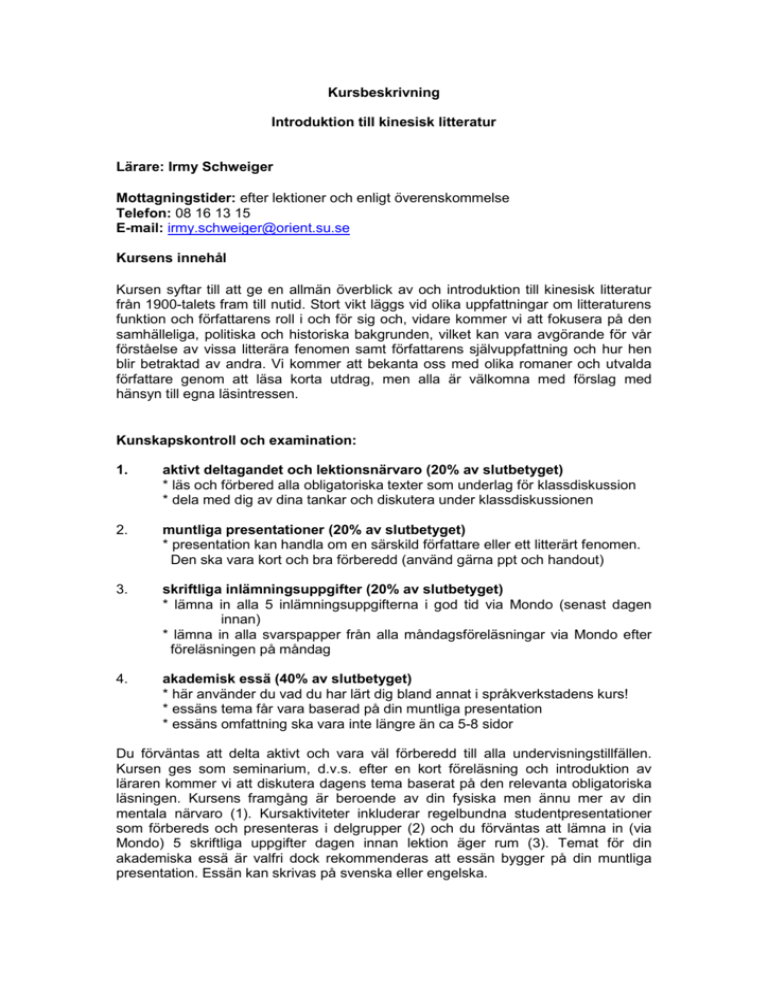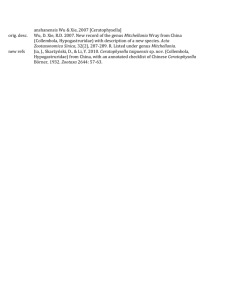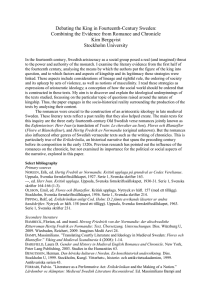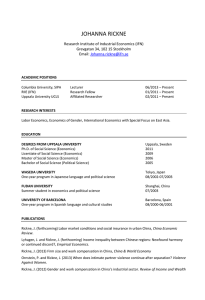Introduktion till kinesisk litteratur
advertisement

Kursbeskrivning Introduktion till kinesisk litteratur Lärare: Irmy Schweiger Mottagningstider: efter lektioner och enligt överenskommelse Telefon: 08 16 13 15 E-mail: irmy.schweiger@orient.su.se Kursens innehål Kursen syftar till att ge en allmän överblick av och introduktion till kinesisk litteratur från 1900-talets fram till nutid. Stort vikt läggs vid olika uppfattningar om litteraturens funktion och författarens roll i och för sig och, vidare kommer vi att fokusera på den samhälleliga, politiska och historiska bakgrunden, vilket kan vara avgörande för vår förståelse av vissa litterära fenomen samt författarens självuppfattning och hur hen blir betraktad av andra. Vi kommer att bekanta oss med olika romaner och utvalda författare genom att läsa korta utdrag, men alla är välkomna med förslag med hänsyn till egna läsintressen. Kunskapskontroll och examination: 1. aktivt deltagandet och lektionsnärvaro (20% av slutbetyget) * läs och förbered alla obligatoriska texter som underlag för klassdiskussion * dela med dig av dina tankar och diskutera under klassdiskussionen 2. muntliga presentationer (20% av slutbetyget) * presentation kan handla om en särskild författare eller ett litterärt fenomen. Den ska vara kort och bra förberedd (använd gärna ppt och handout) 3. skriftliga inlämningsuppgifter (20% av slutbetyget) * lämna in alla 5 inlämningsuppgifterna i god tid via Mondo (senast dagen innan) * lämna in alla svarspapper från alla måndagsföreläsningar via Mondo efter föreläsningen på måndag 4. akademisk essä (40% av slutbetyget) * här använder du vad du har lärt dig bland annat i språkverkstadens kurs! * essäns tema får vara baserad på din muntliga presentation * essäns omfattning ska vara inte längre än ca 5-8 sidor Du förväntas att delta aktivt och vara väl förberedd till alla undervisningstillfällen. Kursen ges som seminarium, d.v.s. efter en kort föreläsning och introduktion av läraren kommer vi att diskutera dagens tema baserat på den relevanta obligatoriska läsningen. Kursens framgång är beroende av din fysiska men ännu mer av din mentala närvaro (1). Kursaktiviteter inkluderar regelbundna studentpresentationer som förbereds och presenteras i delgrupper (2) och du förväntas att lämna in (via Mondo) 5 skriftliga uppgifter dagen innan lektion äger rum (3). Temat för din akademiska essä är valfri dock rekommenderas att essän bygger på din muntliga presentation. Essän kan skrivas på svenska eller engelska. För att få slutbetyg på kursen krävs lägst betyget E på den akademiska essän och fullgjorda obligatoriska uppgifter, För att få A som slutbetyg krävs 95% av alla fullgjorda obligatoriska uppgifter För att få B som slutbetyg krävs 90% av alla fullgjorda obligatoriska uppgifter För att få C som slutbetyg krävs 80% av alla fullgjorda obligatoriska uppgifter För att få D som slutbetyg krävs 70% av alla fullgjorda obligatoriska uppgifter För att få E som slutbetyg krävs 60% av alla fullgjorda obligatoriska uppgifter Du få slutbetyget Fx om du uppnådde mindre än 60% av alla obligatoriska uppgifter Du få slutbetyget F om du uppnådde mindre än 50% av alla obligatoriska uppgifter Om du av någon anledning inte kan delta vid ett särkilt undervisningstillfälle förväntas du ooombedd lämna in en kompletteringsuppgift (hittas på Mondo) Kursuppläggning Kurslitteratur: Knight, Deidre Sabine (2012) Chinese Literature: A Very Short Introduction. Oxford: Oxford UP (rekommenderas att köpa) Karavan. Litterär Tidskrift på resa mellan kulturer. Tema: Nutida Kinesisk Litteratur. Nr. 3, 2013 (rekommenderas att köpa) För en allmänt överblik rekommenderas följande böcker (du hittar alla kursbökerna på hyllan “Kinesisk litteratur kursbokhylla” i Asienbiblioteket, bökerna är tillgängliga för läsning endast I biblioteket): Idema, Wilt and Lloyd Haft (1997) A Guide to Chinese Literature. Center for Chinese Studies: The University of Michigan. McDougall, Bonnie S. and Kam Louie (1997) The Literature of China in the Twentieth Century. New York: Columbia UP. Mostow, Joshua and Kirk A. Denton, China section (2003) (eds) Columbia Companion to Modern East Asian Literatures. NY: Columbia UP (e-bok) 6. februari 1 文以载道 ”Visa vägen genom litteratur” – olika syn på litteratur 2 nyckelord: central tradition, literati, the Way, state examinations, state as patron/ censor, high/trivial literature, literary canon, role of Chinese studies, self-censorship, literary dissent concept, obsession with China Obligatorisk läsning (inlämningsuppgift 1): Ekström, Martin Svensson (2004) “Sågernas bok” i Kinarapport. Sånger och berättelser från tre tusen år, nr. 4, s. 6-9 (kompendiet) Rydholm, Lena (2004) “Poesins guldålder”, “Den sångbara lyriken” i Kinarapport. Sånger och berättelser från tre tusen år, nr. 4, s. 24-31, 34-41 (kompendiet) Kaikkonen, Marja (2004) “Gongfulitteratur – bästsäljare med traditioner” i Kinarapport. Sånger och berättelser från tre tusen år, nr. 4, s. 56-61 (kompendiet) Karavan. Litterär Tidskrift på resa mellan kulturer. Tema: Nutida Kinesisk Litteratur. Nr. 3, 2013 (rekommenderas att du köper) Ytterligare rekommenderade texter: Idema, Wilt and Lloyd Haft (1997) A Guide to Chinese Literature. Center for Chinese Studies: The University of Michigan. Pohl, Karl-Heinz (2009) “Annäherungen an einen Literaturbegriff in China” in Winko, Simone, Jannidis, Fotis and Gerhard Lauer (eds.) (2006) Grenzen der Literature. Zu Begriff und Phänomen des Literarischen. Berlin, New York: Walter de Gruyter, p. 587-607. 13. februari 2 Sent Qing (1895-1911) – På jakt efter moderniteten Nyckelord: Opium war, Sino-Japanese war, Self-Strengthening Movement, Taiping Rebellion, Boxer Rebellion, vernacular language Nyckelpersoner: Liang Qichao, Tan Sitong, Kang Youwei, Lin Shu, Yan Fu, Wu Woyao, Li Baojia, Zeng Pu, Liu E Obligatorisk läsning: Wang, David Der-Wei (2010) “Chinese Literature from 1841-1937” in The Cambridge History of Chinese Literature, Vol. II from 1375. Cambridge: Cambridge UP, p. 440466 (Asienbiblioteket) Lee, Ou-fan Leo “Literary Trends I: The Quest for Modernity, 1895-1927” in Cambridge History of China, Vol. 12, Republican China 1912-1949, Part 1, p. 451464 (Asienbiblioteket) 3 Studentpresentationer: The Qing Reformers Liang Qichao 梁启超, Tan Sitong 谭嗣 同, Kang Youwei 康有为 and New Fiction 新文学;The Qing translators Lin Shu 林 纾, Yan Fu 严复 Ytterligare rekommenderada texter: Dolezelová-Velingerová, Milena (1977) “The Origins of Modern Chinese Literature” in Goldman, Merle (ed.) (1977) Modern Chinese Literature in the May Fourth Era. Cambridge: Harvard UP, p. 17-36. — (ed.) (1980) The Chinese Novel at the Turn of the Century. Toronto: University of Toronto Press. Huters, Theodore (1987) “From Writing to Literature: The Development of Late Qing Theories of Prose” in Harvard Journal of Asiatic Studies 47, 1 (1987) p. 50-96. — (1988) “A New Way of Writing: The Possibility for Literature in Late Qing China, 1895-1908” in Modern China 14, 3 (1988) p. 243-76. — (2005) Bringing the World Home: Appropriating the West in Late Qing and Early Republican China. Honolulu: University of Hawai'i Press. 20. februari 3 Litteraturens Förnyelse – Ikonoklasm och litterär modernitet (1915-1925) nyckelord: 1911 Revolution, Warlord Period (1916-27), May Fourth Incident (1919), founding of the Chinese Communist Party (CCP) (1921), New Culture Movement, Mr. Democracy and Mr. Science, New Youth, Vernacularization Movement nyckelpersoner: Hu Shi, Chen Duxiu, Lu Xun Obligatorisk läsning (inlämningsuppgift): Lu Xun 鲁迅 (1924) 祝福 (Zhufu) Gott Nytt År (kompendiet) Knight, Deidre Sabine (2012) Chinese Literature: A Very Short Introduction. Oxford: Oxford UP (rekommenderas att köpa) Studentpresentation: Hu Shi 胡 适 , Chen Duxiu 陈 独 秀 and the new national language; Lu Xun 鲁迅 och “huset av järn” Ytterligare rekommenderada texter: Lu Xun biography: http://mclc.osu.edu/rc/bios/lxbio.htm 4 Chen, Pingyuan (2011) Touches of History: An Entry into "May Fourth" China. Trs. Michel Hockx, with Maria af Sandelberg, Uganda Sze Pui Kwan, Chistopher Neil Payne and Christopher Rosenmeier. Leiden: Brill. Denton, Kirk A (1996) “Introduction” in Denton, Modern Chinese Literary Thought: Writings on Literature, 1893-1945. Stanford: Stanford UP, p. 1-61. Dolezelova-Velingerova, Milena and Oldrich Kral (2001) (eds) The Appropriation of Cultural Capital: China's May Fourth Project. Cambridge: Harvard University Asia Center. Eastman, Lloyd E. (1991) “The May Fourth Movement as a Historical Turning Point: Ecological Exhaustion, Militarization, and Other Causes of China's Modern Crisis” in K. Lieberthal et al., (1991) (eds) Perspectives on Modern China: Four Anniversaries. Armonk: M.E. Sharpe, p. 123-38. Goldman, Merle (1977) (ed) Modern Chinese Literature in the May Fourth Era. Cambridge: Harvard UP. Galik, Marian (1990) (ed) Interliterary and Intraliterary Aspects of the May Fourth Movement 1919 in China. Bratislava: Veda. Hockx, Michel (2006) Question of Style: Literary Societies and Literary Journals in Modern China. Leiden: E. J. Brill. Lu Xun 鲁迅 (1918) Diary of a Madman 狂人日记 27. februari 4 Romantiker och Individualister (1920s), Mandarinands- och fjärilslitteratur 鸳 鸯蝴蝶派 (1930s) Nyckelord: romantic individualism, alienation of the Individual (Wertherian), utopianism, heroic romanticism (Promethean), subjectivism, diaries, letters, autobiographies, first-person story, Mandarin Ducks and Butterflies, Saturday (libailiu), mass literature, consumerism, development of commercial press, popular fiction, satirical novel criticizing corruption, bureaucracy, social injustices Nyckelpersoner: Yu Dafu, Guo Moruo, Zhang Henshui, Liu E Obligatorisk läsning: Lee, Leo Ou-fan (1973) “Yü Ta-fu: Driftings of a Loner” in Lee, Leo Ou-fan (1973) The Romantic Generation of Modern Chinese Writers. Cambridge: Harvard UP, p. 81-109 (Asienbiblioteket) Yu Dafu 郁达夫 “Chenlun” 沉沦 (Sinking) (kompendiet) “Zhou Shoujuan’s Love Stories and Mandarin Ducks and Butterflies Fiction” in Mostow, Joshua and Kirk A. Denton, China section (2003) (eds) Columbia Companion to Modern East Asian Literatures. NY: Columbia UP, chapt. 64 (e-bok) 5 Su Manshu “Sui zan ji” (The broken hairpin), 1916 in Yau-Woon Ma and Joseph S. M. Lau. Traditional Chinese stories: themes and variations (Asienbiblioteket) (http://books.google.se/books?id=P5FMoYeO4lYC&pg=PA234&lpg=PA234&dq=Su+ Manshu+the+broken+hairpin&source=bl&ots=KQuDPCjpwc&sig=NOkPzV7B2F26B4 nqcKU8k2ThDl0&hl=sv&sa=X&ei=lgy0UpypBK3V4QSKyoGYCg&ved=0CDAQ6AEw AA#v=onepage&q=Su%20Manshu%20the%20broken%20hairpin&f=false) Studentpresentation: Literary Societies 文学社会 and Literary Journals, Yu Dafu 郁 达夫, Shanghai Modernists Liu Na’ou 刘呐鸥, Mu Shiying 穆时英, Shi Zhecun 施蛰 存, Tidskrift “Saturday” 礼拜六, Zhang Henshui 張恨水, Xu Zhenya 徐枕亚, Bao Tianxiao 包天笑 , Ytterligare rekommenderada texter: Chan, Wing-ming (1990) “The Self-Mocking of a Chinese Intellectual: A Study of Yu Dafu’s An Intoxicating Spring Night” in Galik, Marian (1990) (ed.) Interliterary and Intraliterary Aspects of the May Fourth Movement 1919 in China. Bratislava: Veda, p. 111-118. Denton, Kirk (1992) “The Distant Shore: The Nationalist Theme in Yu Dafu’s Sinking” in Chinese Literature Essays, Articles and Reviews 14 (1992): 107-23. [JSTOR link] Dolezalova, Anna (1970) Yu Ta-fu: Specific Traits of his Literary Creation. Bratislava: Publishing House of the Slovak Academy of Sciences. Egan, Michael (1977) “Yu Dafu and the Transition to Modern Chinese Literature” in Goldman, Merle (1977) (ed.) Modern Chinese Literature in the May Fourth Era. Cambridge: Harvard University Press, p. 309-24. Feuerwerker, Yi-tsi Mei (1993) “Text, Intertext, and the Representation of the Writing Self in Lu Xun, Yu Dafu, and Wang Meng” in Widmer, Ellen and David Wang (1993) (eds.) From May Fourth to June Fourth: Fiction and Film in Twentieth-Century China. Cambridge: Harvard UP, p. 167-93. Findeisen, Raoul and Robert Gassmann (1997) (eds) Autumn Floods: Essays in Honour of Marian Galik. Bern: Peter Lang. Gimpel, Denise (1990) “Beyond Butterflies: Some Observations on the Early Years of the Journal Xiaoshuo yuebao” in Michel Hockx (1990) (ed) The Literary Field of Twentieth Century China. Honolulu: University of Hawaii Press, p. 40-60. Hockx, Michel (2003) Questions of Style: Literary Societies and Literary Journals in Modern China. Leiden: E.J. Brill. Hockx, Michel (2003) Questions of Style: Literary Societies and Literary Journals in Modern China. Leiden: E.J. Brill. Lee, Leo Ou-fan (1973) The Romantic Generation of Modern Chinese Writers. Cambridge: Harvard UP. 6 — (1973) “The Romantic Temper in May Fourth Writers” in Schwartz, Benjamin I. (ed.) (1973) Reflections on the May Fourth Movement: A Symposium. Cambridge: Harvard UP p. 69-84. Levan, Valerie (2010) Forbidden Enlightenment: Self-Articulation and SelfAccusation in the Works of Yu Dafu (1896-1945). Ph. D. diss. Chicago: University of Chicago. Tang, Xiaobing with Michel Hockx (2008) „The Creation Society (1921-1930)” in Denton, Kirk A. and Michel Hockx (eds.) (2008) Literary Societies in Republican China. Lanham, MD: Lexington Books, p. 103-36. Tang, Chenxi (2005) “Reading Europe, Writing China: European Literary Tradition and Chinese Authorship in Yu Dafu’s Sinking” in Arcadia 40, 1, p. 153-76. Schwartz, Benjamin (1973) (ed) Reflections on the May Fourth Movement: A Symposium. Cambridge: East Asian Research Center, Harvard University, 1973. Fruehauf, Heinrich (1990) Urban Exoticism in Modern Chinese Literature, 19101933. Ph.D. diss. Chicago: University of Chicago. Gunn, Edward (1980) The Unwelcome Muse: Chinese Literature in Shanghai and Peking, 1937-1945. NY: Columbia UP. — (1993) "Literature and Art of the War Period" in Hsiung, James et. al. (eds.) (1993) China's Bitter Victory: The War with Japan, 1937-1945. Armonk: M.E. Sharpe, p. 235-74. Lee, Leo Ou-fan (1999) Shanghai Modern: The Flowering of a New Urban Culture in China. Cambridge Mass.: Cambridge UP. Link, Perry (1981) “Introduction” in Mandarin Ducks and Butterflies: Popular Fiction in the Early Twentieth-Century Chinese Cities. Berkley: UCP, p. Liu Ts’un Yan (1984) (ed) Chinese Middle-brow fiction. From the Ch’ing and the Early Republican Era. Armonk, NY: M.E. Sharpe. Wang, David Der-wei (1997) Fin-de-siecle Splendor: Repressed Modernities of Late Qing Fiction, 1848-1911. Stanford: Stanford UP, 1997. Zhang Henshui (1895-1967) “Fate in Tears and Laughter” (excerpt) in Liu Ts’un-yan (ed.) with assistance of John Minford (1984) Chinese Middlebrow Fiction from the Ch’ing and Early Republican Eras. Hongkong: Chinese UP, p. 264-287 6. mars 5 Från kriget till revolutionen – feminism och revolution Keywords: foot binding, illiteracy, marriage system, “women question” Key figures: Ling Shuhua, Ding Ling, Xiao Hong, Henrik Ibsen Obligatorisk läsning: 7 “Reconsidering the Origins of Modern Chinese Women’s Writing“ in Mostow, Joshua Mostow and Kirk A. Denton, China section (eds.) (2003) Columbia Companion to Modern East Asian Literatures. NY: Columbia UP, chapter 66, p. 371-377. (e-bok) “Feminism and Revolution: the Work and Life of Ding Ling“ in Mostow, Joshua Mostow and Kirk A. Denton, China section (eds.) (2003) Columbia Companion to Modern East Asian Literatures. NY: Columbia UP, chapter 69, p. 395-400. (e-bok) Feuerwerker, Yi-tsi Mei (1977) “The Changing Relationship between Literature and Life: Aspects of the Writer's Role in Ding Ling [Ting Ling]” in Goldman, Merle (1977) (ed.) Modern Chinese Literature in the May Fourth Era. Cambridge: Harvard University Press, p. 281-307 (kompendiet) Ding Ling 玎 玲 “Shafei nüshi riji” 莎 菲 女 士 的 日 记 (Diary of Miss Sophie) (kompendiet) studentpresentation Zhang Ailing 张爱玲 , Ding Ling 丁玲 , women literature Ytterligare rekommenderada texter: Alber, Charles J. (2004) Embracing the Life: Ding Ling and the Politics of Literature in the PRC. Westport, CT: Praeger. Apter, David and Tony Saich (1994) Revolutionary Discourse in Mao's Republic. Cambridge: HUP. Barlow, Tani (1993) (ed) Gender Politics in Modern China: Writing and Feminism in Modern China. Durham N.C.: Duke UP. Chow, Rey (1991) Woman and Chinese Modernity: The Politics of Reading Between West and East. Minneapolis: U. of Minnesota Press. Duke, Michael (ed.) (1989) Modern Chinese Women Writers: Critical Appraisals. Armonk: M.E. Sharpe. Feuerwerker, Yi-tsi Mei (1982) Ding Ling's Fiction: Ideology and Narrative in Modern Chinese Literature. Cambridge: Harvard UP. — (1977) “The Changing Relationship between Literature and Life: Aspects of the Writer's Role in Ding Ling [Ting Ling]” in Goldman, Merle (1977) (ed.) Modern Chinese Literature in the May Fourth Era. Cambridge: Harvard University Press, p. 281-307. Gunn, Edward (1993) “Literature and Art of the War Period” in Hsiung, James et. al. (eds.) (1993) China’s Bitter Victory: The War with Japan, 1937-1945. Armonk: M.E. Sharpe, p. 235-74. Larson, Wendy (1993) "The End of 'Funu wenxue': Women's Literature from 1925 to 1935" in Modern Chinese Literature 4, 1/2 (1988), p. 39-54. 8 — (1993) "Female Subjectivity and Gender Relations: The Early Stories of Lu Yin and Bing Xin" in Tang Xiaobin and Liu Kang (eds.) (1993) Politics, Ideology, and Literary Discourse in Modern China: Theoretical Interventions and Cultural Critique. Durham: Duke UP, p. 124-43. — (1998) Women and Writing in Modern China. Stanford: Stanford UP. Wang, Jing M. (2008) When "I" Was Born: Women's Autobiography in Modern China. Madison: University of Wisconsin Press. Anderson, Marsten (1990) The Limits of Realism: Chinese Fiction in the Revolutionary Period. Berkeley: University of California Press. McDougall, Bonnie S. and Kam Louie (1997) “Return to Tradition” in McDougall, Bonnie S. and Kam Louie (1997) The Literature of China in the Twentieth Century. New York: Columbia UP, p. 189-207. Gunn, Edward (1980) The Unwelcome Muse: Chinese Literature in Shanghai and Peking, 1937-1945. NY: Columbia UP. — (1993) “Literature and Art of the War Period” in Hsiung, James et. al. (1993) (eds) China’s Bitter Victory: The War with Japan, 1937-1945. Armonk: M.E. Sharpe, p. 235-74. Laughlin, Charles A. (1998) “The Battlefield of Cultural Production: Chinese Literary Mobilization during the War Years” in Journal of Modern Literature in Chinese 2, 1 (July 1998), p. 83-103. 13. mars 6 Litteratur “I folkets tjänst” - Yan’an konferensen om litteratur och konst (1942) Keywords: rectification campaign, worker-peasant-soldier-literature, culture as tool in the revolutionary machinery Key persons: Ding Ling, Ai Qing, Xiao Jun, Wang Shiwei, Hao Ran Obligatorisk läsning (inlämningsuppgift): “Cultural Policy in the People’s Republic. Talks at the Yan’an Forum on Art and Literature. Mao Zedong” 在延安文艺座谈会上的讲话.毛泽东 in Documenting China. A Reader in Seminal Twentieth-Century Texts. Comp. ed. and introduced by Margaret Hillenbrand and Cloë Starr. University of Washington Press: Seattle & London, p. 58-71 (kompendiet) 9 Denton, Kirk A. (2003) “Literature and Politics: Mao Zedong’s Talks at the Yan'an Forum on Art and Literature” in Mostow, Joshua Mostow and Kirk A. Denton, China section (2003) (eds.) Columbia Companion to Modern East Asian Literatures. NY: Columbia UP, p. 463-69 (e-bok) King, Richard (2003) “The Hundred Flowers” in Mostow, Joshua Mostow and Kirk A. Denton (2003) eds. Columbia Companion to Modern East Asian Literatures. NY: Columbia UP p. 476-80 (e-bok) Hao Ran (1961) “Den solbelysta vägen” in Hao Ran (1977) Den klara källan. Noveller från dagens Kina av Hao Ran. Gidlunds förlag, p. 61-84 (kompendiet) Studentpresentation: Wang Shiwei 王实味 , Hao Ran 浩然 Ytterligare rekommenderada texter: Brokow, Cythia and Christopher A. Reed (2010) (ed) From Woodblocks to the Internet: Chinese Publishing and Print Culture in Transition, circa 1800 to 2008. Leiden, Bosten: Brill. Dai Qing (1994) Wang Shiwei and White Lilies: Rectification and Purges in the Chinese Communist Party, 1942-1944. Armonk N.C. New York: M. E. Sharpe. Cheek, Timothy (1984) “The Fading of Wild Lilies: Wang Shiwei and Mao Zedong's Yan'an Talks in the First CCP Rectification Movement” in Australian Journal of Chinese Affairs 11 (1984): 25-58. Holm, David (1982) “The Literary Rectification in Yan'an” in Kubin, Wolfgang and R. G. Wagner (eds.) (1982) Essays in Modern Chinese Literature and Literary Criticism. Bochum: Brockmeyer, p. 272-308. — (1984) “Folk Art as Propaganda: The Yangge Movement in Yan'an” in McDougall, Bonnie (ed.) (1984) Popular Chinese Literature and Performing Arts in the PRC, 1949-1979. Berkeley: UCP, p. 3-35. — (1991) Art and Ideology in Revolutionary China. Oxford: Clarendon. Laughlin, Charles A. (2002) Chinese Reportage: The Aesthetics of Historical Experience. Durham: Duke University Press. 20. mars 7 “Låt hundra blommor blomma och låt hundra tankeskolor tävla!” (1956) Keywords: writers union, Hundred Flowers Movement, Anti-Rightist Campaign, Great Leap Forward, Cultural Revolution, model operas; Key figures: Liu Binyan, Wang Meng, Qin Zhaoyang, 10 Obligatorisk läsning: Hao Ran (1961) “Den solbelysta vägen” in Hao Ran (1977) Den klara källan. Noveller från dagens Kina av Hao Ran. Gidlunds förlag, p. 61-84 (kompendiet) Leo Ou-fan Lee, “Literary Trends II: the Road to Revolution,”The Cambridge History of China vol.13, Cambridge: Cambridge University Press, p. 421-491 (kompendiet) King, Richard (2003) “The Hundred Flowers” in Mostow, Joshua and Kirk A. Denton, China section (eds.) (2003) Columbia Companion to Modern East Asian Literatures. NY: Columbia UP, p. 476-80 (e-bok) King, Richard (2003) “The Hundred Flowers” in Mostow, Joshua and Kirk A. Denton, China section (eds.) (2003) Columbia Companion to Modern East Asian Literatures. NY: Columbia UP, p. 476-80 (e-bok) studentpresentation: Jiang Qing 江青,Cultural Revolution Model Theatre 革命样 板戏 ,Liu Binyan 刘宾雁, Wang Meng 王蒙, The Hundred Flowers Movement 百花 齐放,百家挣命, Hao Ran 浩然 Ytterligare rekommenderada texter: Birch, Cyril (1986) “Literature Under Communism” in MacFarquhar, Roderick and John King Fairbank (eds.) (198) Cambridge History of China. Vol. 15, The People's Republic of China, part 2. Cambridge: Cambridge UP, p. 743-812. Chan, Sylvia (1979) “The Image of a 'Capitalist Roader': Some Dissident Short Stories in the Hundred Flowers Period” in Australian Journal of Chinese Affairs 2 (July 1979), p. 72-102. — (1980) “The Blooming of the 'Hundred Flowers' and the Literature of the 'Wounded Generation'” in Brugger, Bill Brugger (ed.) (1980) China Since the 'Gang of Four'. London: Croom Helm, p. 174-201. Denton, Kirk A. (2010) “Rectification: Party Discipline, Intellectual Remolding, and the Formation of a Political Community” in Ban Wang (ed.) (2010) Words and Their Stories: Essays on the Language of the Chinese Revolution. Leiden: Brill, p. 51-63. King, Richard, Ralph C. Croizier, Scott Watson, and Sheng Tian Zheng (eds.) (2010) Art in Turmoil: The Chinese Cultural Revolution, 1966-76. Vancouver: UBC Press. Yang, Lan (1998) Chinese Fiction of the Cultural Revolution. HK: HKUP. 27. mars 8 Beijingvåren och den nya perioden (1976) Keywords: scar literature, obscure poetry, new critical realism, cultural reflection literature, roots literature, avant-garde literature, trauma literature Obligatorisk läsning (inlämningsuppgift): 11 Liu Xinwu 刘心武 (1977) The Class Councelor 班主任 (kompendiet) Lu Xinhua (1979) “The Wounded” in Lee, Bennett and Geremie Barmé (1979) (eds.) The Wounded, New Stories of the Cultural Revolution 1977-78. Hong Kong p. 9-24 (kompendiet) Wu, Liang (2000) “Re-membering the Cultural Revolution: Chinese Avant-garde Literature of the 1980s” in Chi Pang-yuan and David Wang (eds.) (2000) Chinese Literature in the Second Half of the Twentieth Century: A Critical Survey. Bloomington: Indiana UP, p. 125-36 (kompendiet) Knight, Deirdre Sabina (2003) “Scar Literature and the Memory of Trauma” in Mostow, Joshua and Kirk A. Denton, China section (eds.) (2003) Columbia Companion to Modern East Asian Literatures. NY: Columbia UP, p. 554-60 (e-bok) Kam, Louie (1989) “Educated Youth Literature: Self-Discovery in the Chinese Villages“ in Kam, Louie (1989) Between Fact and Fiction: Essays On Post-Mao Chinese Literature and Society. Sydney p. 91-102 (kompendiet) Mostow, Joshua and Kirk A. Denton (2003) eds. Columbia Companion to Modern East Asian Literatures. NY: Columbia UP p. 527-32 (e-bok) Leenhouts, Mark (2003) “Culture Against Politics: Roots-Seeking Literature”, in Mostow, Joshua and Kirk A. Denton (2003) eds. Columbia Companion to Modern East Asian Literatures. NY: Columbia UP, p. 533-40 (e-bok) Studentpresentation: Han Shaogong 韩少功, och root searching litteratur 寻根文学 Wang Shuo 王朔 och hooligan literature 流氓文学, Yan Lianke 阎连科, Liu Xinwu 刘心武 Ytterligare rekommenderada texter: Huang, Yibing. Contemporary Chinese Literature: From the Cultural Revolution to the Future. NY: Palgrave Macmillan, 2007. Huot, Marie Claire (2000) China's New Cultural Scene: A Handbook of Changes. Durham: Duke UP. Wang, Jing (1997) High Culture Fever: Politics, Aesthetics, and Ideology in Deng's China. Berkeley: University of California Press. 4. april 9 Post-4 juni 1989 litteratur – folkliga litteratur 民间文学 Nyckelord: nyckelpersoner: Bei Dao, Duo Duo, Yu Hua, Wang Shuo, Yang Lian 12 Obligatorisk läsning (inlämningsuppgift): Yu Hua 余华 (1986) On the Road at Eighteen 十八岁出门远行 (kompendiet) Wang Yiyan (2006) “The life and career of Jia Pingwa” in Wang Yiyan Narrating China. Jia Pingwa and his fictional world. Routledge Contemporary China Series, p. 26-49 (kompendiet) Jones, Andrew F. (2003) “Avant-Garde Fiction in China” in Mostow, Joshua and Kirk A. Denton, China section (eds.) (2003) Columbia Companion to Modern East Asian Literatures. NY: Columbia UP, p. 554-60 (e-bok) studentpresentation: Tidskrift Jintian 今天 (Today), Bei Dao 北岛, Yu Hua 余华, Wang Shuo 王朔 Ytterligare rekommenderada texter: Yeh, Michelle (2003) “Misty Poetry” in Mostow, Joshua and Kirk A. Denton, China section (eds.) (2003) Columbia Companion to Modern East Asian Literatures. NY: Columbia UP, p 520-26. Zhao, Henry (1993) “New Waves in Recent Chinese Fiction” in Zhao, Henry (ed.) (2003) The Lost Boat: Avant-garde Fiction from China. London: Wellsweep, p. 9-18. 10. april 10 Kinas litteratur och Nobelpriset: Mo Yan 莫言 och Gao Xingjian 高行健 nyckelord: Nobel complex, world literature, Nobel Prize nyckelpersoner: Mo Yan, Gao Xingjian, Pearl S. Buck Obligatorisk läsning: Mo Yan 莫言 (1984) “The Transparent Radish 透明的红萝卜“ (kompendiet) Gao Xingjian (2000) Nobel Lecture by Gao Xingjian http://www.nobelprize.org/mediaplayer/index.php?id=1394 Braester, Yomi (2003) “Mo Yan and Red Sorghum” in Joshua Mostow, ed, and Kirk A. Denton, China section, ed., Columbia Companion to Modern East Asian Literatures. NY: Columbia UP, 2003, 541-45 (e-bok) studentpresentation: Mo Yan 莫言,Gao Xingjian 高行健,Nobelpriset, Jia Pingwa 贾平凹 13 Ytterligare rekommenderada texter: Nobel Lecture by Mo Yan (2012): http://www.nobelprize.org/mediaplayer/index.php?id=1868 Chan, Shelley W. (2011) A Subversive Voice in China: The Fictional World of Mo Yan. Amherst, NY: Cambria Press. Duke, Michael (1993) Past, Present, and Future in Mo Yan's Fiction of the 1980s.” in Ellen Widmer and David Wang (1993) (eds) From May Fourth to June Fourth: Fiction and Film in Twentiety-Century China. Cambridge: Harvard UP, p. 295-326. Lovell, Julia (2006) The Politics of Cultural Capital – China’s Quest for a Nobel Prize in Literature. University of Hawai’i Press: 14


